ピアニストが自身の限界を超える技能を身体で覚える手法を発見
~ ロボットがもたらす「従来不可能」な動きが、技能の限界を突破する ~
株式会社ソニーコンピュータサイエンス研究所(代表取締役社長:北野宏明 以下、ソニーCSL)は、国立研究開発法人科学技術振興機構(JST) ムーンショット型研究開発制度(ムーンショット目標1)および戦略的創造研究推進事業において、ピアニストの複雑で素早い手指の動きを向上させるトレーニング法を発見しました。この成果は、ソニーCSL – 東京リサーチ リサーチディレクターの古屋晋一らによるものです。
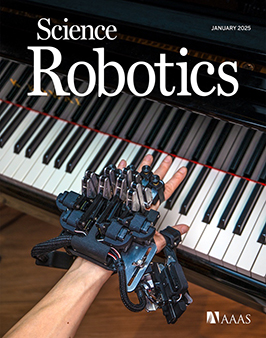
音楽家やアスリート、外科医をはじめとする熟練者は、卓越した技能を洗練し続けています。しかし、膨大な練習を経て技能は時に頭打ちになり、その限界を突破する方法は完全には解明されていません。
研究チームは、5本の指を独立かつ高速度に動かせる「外骨格ロボット」を用いて、自力では不可能な複雑で高速度な手指の動きを体験できるトレーニングを開発しました。このロボットを装着後に行ったトレーニングでは、頭打ちになっていた技能が向上することが明らかになりました。また、この技能の向上は、トレーニングを行っていない反対の手指にも起こりました。
この発見は熟練者の技能の限界には、練習の質次第で伸ばせる余地が存在していることを示唆しています。そのため、本研究成果は、新しいトレーニングプログラムの創出や、熟練者特有の学習の仕組みやその背後にある脳神経系の働きの解明、また過剰な訓練を回避し故障・怪我を予防する練習方法の開発などに役立つことが期待されます。
なお本研究成果は2025年1月15日に国際科学誌「Science Robotics」で公開されました。
<研究の背景と経緯>
音楽家をはじめとするパフォーミングアーティスト、アスリート、外科医、伝統工芸の職人など、さまざまな分野でエキスパートと呼ばれる熟練者の技能は、長年にわたる膨大なトレーニングを経て獲得されます。しかし、トレーニングよる技能の向上がやがて頭打ちになる「天井効果」は、技能をさらに洗練する上で、長年大きな課題でした。
従来、天井効果を突破するため、多くの熟練者はトレーニングの量を増やしていました。しかし、それは怪我や障害の発症リスクを高めます。また近年、トレーニングの量を増やしても、天井効果を突破する十分な効果が得られないという報告も相次いでいます(図1)。
トレーニングの質を高める上での妨げの一つは、熟練者がさらに目標とする高度な技能は、複雑で高速度なため、事前に体験できない上、言葉を介した動作の理解が困難であることが挙げられます。そのため、卓越した技能を身体で覚えることは、これまで不可能とされてきました。
<研究の内容>
ソニーCSLは、個々の指を独立かつ高速に長時間安定して動かせる外骨格ロボットを用いた新しいトレーニング方法が、ピアニストの指の運動技能の天井効果を打破可能であることを発見しました。
研究チームは、熟練者として、高度なスキルを持つピアニストを対象に、外骨格ロボットを装着し、自力では不可能な高速かつ複雑な指の動きを体験させるトレーニングを実施しました。その結果、トレーニングを受けたピアニストは、事前の練習で頭打ちになった演奏技能の限界を突破し、複雑な技能をさらに素早く遂行できるようになりました(図2)。さらに、技能の向上は、外骨格ロボットを用いたトレーニングを受けていない反対の手にも現れました。これらの効果は、外骨格ロボットを手から外して演奏した際に現れたため、ピアニスト自身の技能が向上したと考えられます。
このような技能の天井効果の打破にある仕組みを明らかにするために、いくつかの実験を実施しました。まず、外骨格ロボットがどのような動きを生成すると、トレーニング後の演奏技能が向上するかを明らかにするため、ロボットの動きの複雑さや速度を操作しました。その結果、単純で素早い手指の動きを体験した後や、複雑な動作をゆっくり体験した後には、技能の向上は観察されませんでした。次に、5本の指一つ一つの筋力や俊敏性を検査した結果、外骨格ロボットを用いたトレーニングの後、これら指の運動機能に変化は現れませんでした。同様に、手指の動きの知覚機能にも、トレーニング前後で変化は見られませんでした。これらの結果は、自力では不可能な複雑で高速度な技能をロボット技術により体験することによって、その後の演奏技能が向上すること、その背景には複雑な動きを司る中枢神経系の変化が伴うことを示唆しています(図3)。
トレーニング効果の背景にある脳の働きの変化を明らかにするために、生体を傷つけず(非侵襲)大脳皮質の働きを磁気刺激によって評価する検査(経頭蓋磁気刺激)をトレーニング前後に実施しました。指の動きの生成を担う大脳皮質の運動野と呼ばれる領域に頭皮上から磁気刺激を与えて生じた手指の動きを、データグローブと呼ばれるセンサーで計測し、その動きのパターンをテンソル分解と呼ばれるデータサイエンスの手法で解析しました。その結果、複雑な手指動作を外骨格ロボットにより体験した後、体験した動きのパターンにより類似した手指の動きが、磁気刺激検査によって生じることが明らかになりました。これは、体験した複雑動作を生成しやすいように大脳皮質運動野の機能が可塑的に変化したことを示唆しています。
これらの実験をピアニスト90名を対象に実施した結果、手指に外骨格ロボットを装着して複雑で高速度な手指の動きを体験するトレーニングの実施により、ロボットを脱着した後もトレーニングを実施した手とその反対の手の両方で技能向上が確認できており、その背景には大脳皮質運動野の可塑的変化が関わっていることが明らかになりました。<今後の展開>
今回の研究によって、トレーニングの量を増やしても上達しない「技能の頭打ち」においては、技能の天井効果ではなく、新しい体験を経てさらに上達する伸びしろが存在する可能性が示唆されました。ロボット技術や仮想現実技術は、これまで人が装着した状態で能力が拡張する用途に主眼が置かれてきましたが(例:ヒューマンオーグメンテーション)、今後はこれらの先進技術を巧みに利用したトレーニングを通して、従来の能力の限界とされてきた水準を突破する新しい学問の方向性が示されました。これにより、人間の未知の能力の開拓や、その背景にある脳の可塑性の仕組みの解明が一層深まることが期待されます。また、自らの身体を用いて上達し、新たなことができるようになる感動は、ピアノ演奏に限らず、スポーツや外科手術など、様々な分野で共通しています。そのため、本研究成果は、人が身体や脳の制約から解放された社会の実現に貢献し、多くの分野へ波及効果を創出することが期待されます。
音楽の学びは、スポーツに比べると、サイエンスやテクノロジーを関与させた質的貢献が大幅に遅れています。そのため、創造性を具現化する上で、心身の制約に苦しむ課題の多くは、未解決のままです。本研究成果を用いたトレーニングの提供は、音楽演奏の科学(ダイナフォーミックス)のエビデンスに基づく新しい音楽教育の確立を通して、アーティストが心身の制約から解放されて創造性を具現化する未来社会の創生に貢献します。その上で、複雑な動作を素早く実現する技能は、多彩な演奏表現を具現化するためのごく一部の技能であるため、多種多様な表現の具現化と選択を可能にするトレーニングの創出や、アーティストのニーズに寄り添ったトレーニングの効果検証に取り組むことが、今後期待されます。
<参考図>
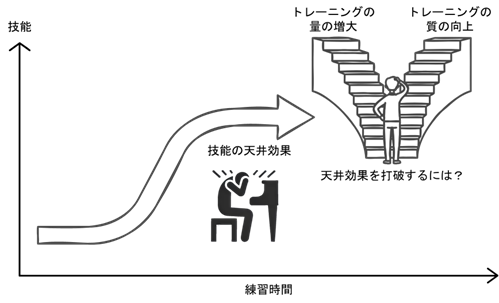
図1 技能の天井効果とそれを打破するトレーニング
膨大な練習を経て、脳は獲得した技能を固定化し、技能の上達が頭打ちになることが知られている(Furuya et al. 2014 J Neurosci)。このような”技能の天井効果”を突破するためには、従来、膨大な量のトレーニングが必要と考えられてきた(例:deliberate practice,一万時間の法則)。しかし、近年、トレーニングの量だけでは、さらなる上達は困難であることを示す研究報告が相次いでいる。
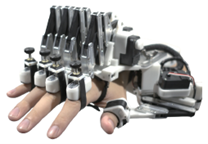
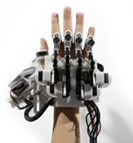
図2 手指の外骨格ロボット
手指に装着し、個々の指を独立して動かせる外骨格ロボット。実験は、人差し指と薬指を同時に屈曲し,その際に中指と小指を同時に伸展する動作と,その反対方向の動作と連続して行うことを1往復とし,1秒間に4往復の高速度で交互に繰り返すことを30分間実施した。この受動的に指を動かされるトレーニングは、空中で指先に何も接触しない状態で、安静状態で行った。その前後で、外骨格ロボットを外した状態で、ピアノ上で同じ課題を最速度で演奏する際の動きを計測した(3度のトリル課題)。
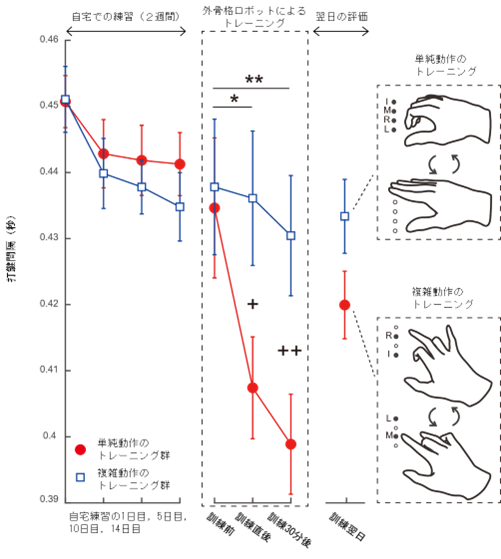
図3 外骨格ロボットによるトレーニングが技能の天井効果を打破するか調べた実験
トレーニングを実施する前に、技能が天井効果に達した状態にするため、2週間に渡り被験者であるピアニストは自宅でピアノ課題を練習した。技能が頭打ちになった後、ピアニストは外骨格ロボットを手指に装着して、手指が受動的に動かされるトレーニングを実施した。トレーニングは、複雑な手指運動を高速度で体験する群と,単純な手指運動を高速度で体験する群の2群とした。トレーニング前後に、外骨格ロボットを手指から外し、ピアノで課題を最速度で演奏し、トレーニングの効果を評価した。その結果、複雑な手指運動を体験した群のみ、トレーニング後に正確性を保持したままより速く演奏できるようになることが明らかになった。その効果は30分後も保持され、翌日には減弱するも効果は残存することが認められた。
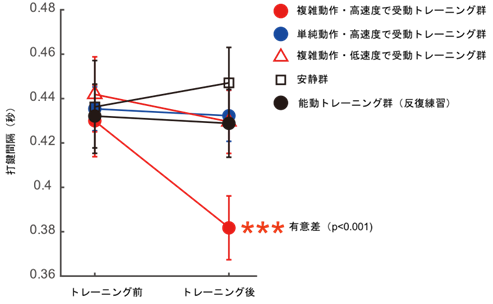
図4 受動トレーニングの効果の特異性
外骨格ロボットを手指に装着し、指の動きを体験する受動トレーニングの効果が、指の動かし方に依存するのかを調べるために、異なる介入条件での実験を実施した。高速度での複雑動作を受動的に体験する群、高速度での単純動作を受動的に体験する群、低速度での複雑動作を受動的に体験する群、安静にするのみの群、ピアノで複雑動作から成る演奏課題を反復練習する群で、複雑動作から成る演奏課題の最速演奏を介入前後で評価した。その結果、外骨格ロボットを介して、高速度での複雑動作を受動的に体験したピアニストらのみ、正確性を保持したままより速く演奏できるようになった。
<論文タイトル>
“Surmounting the ceiling effect of motor expertise by novel sensory experience with a hand exoskeleton”
(外骨格ロボットを用いた未体験の感覚体験による演奏技能の天井効果の打破)
DOI:https://doi.org/10.1126/scirobotics.adn3802
なお、本成果は以下の事業・研究領域・研究課題によって得られました。
ムーンショット型研究開発制度(MOONSHOT)
研究領域:「2050年までに、人が身体、脳、空間、時間の制約から解放された社会を実現」
(研究総括:萩田 紀博 大阪芸術大学 芸術学部 アートサイエンス学科 学科長・教授)
研究課題名:「身体的能力と知覚能力の拡張による身体の制約からの解放」
研究代表者:金井 良太(株式会社 国際電気通信基礎技術研究所)
研究期間:令和2年10月 ~ 令和8年3月
戦略的創造研究推進事業 チーム型研究(CREST)
研究領域:「人間と情報環境の共生インタラクション基盤技術の創出と展開」
(研究総括:間瀬 健二 名古屋大学 大学院情報学研究科 教授)
研究課題名:「技能獲得メカニズムの原理解明および獲得支援システムへの展開」
研究代表者:小池 英樹(東京工業大学 情報理工学院 教授)
研究期間:平成29年10月 ~ 令和5年3月
株式会社ソニーコンピュータサイエンス研究所
csl-pr@csl.sony.co.jp
Pianist Discovers Method for Body to Learn Skills that Surpass Human Limits
~ Robot-generated “conventionally impossible” movements break through skill limitations ~
Tokyo, Japan ー Sony Computer Science Laboratories (hereinafter “Sony CSL,” President: Hiroaki Kitano) has discovered a training method to improve the complex, high-speed hand and finger movements of pianists, through its work under the Moonshot Research and Development Program (Moonshot Goal 1) and the Core Research for Evolutionary Science and Technology (CREST) Strategic Creative Research Promotion Program of the Japan Science and Technology Agency (JST). This result was achieved by a team led by Shinichi Furuya, Research Director of Tokyo Research at Sony CSL.

Musicians, athletes, surgeons, and other skilled people continually work to refine their already exceptional skills. However, after tremendous amounts of practice, skills sometimes level off, and the methods for breaking through such limitations have not been completely solved.
Sony CSL’s research team developed a training method using an exoskeleton robot that moves the five fingers independently and at high speed to experience complex, high-speed finger movements that humans cannot execute themselves. Training conducted after one hand was fitted with the robot revealed improvement in skills that had plateaued. Skill improvement also occurred in the other hand, which had not been trained.
This discovery suggests that, depending on practice quality, there is leeway to extend a skilled person’s skill limitations. These research findings are thus expected to be useful for creating new training programs and clarifying mechanisms of learning that are unique to skilled players and the function of the central nervous system behind such learning, as well as for developing practice methods that avoid excessive training and prevent disorders and injuries.
These results were published in the international scientific journal Science Robotics on January 15, 2025.
<Background behind the research>
Performing artists, athletes, surgeons, traditional craftspeople, and other experts in various fields acquire their skills through extensive training over many years. However, the “ceiling effect,” in which trained skills eventually plateau, has long posed a major challenge to further refining these skills.
Until now, many skilled individuals have increased their amount of training in order to break through the ceiling effect. However, doing this increases the risk of a disorder or injury. In recent years, there has also been a series of reports stating that even boosting the amount of training is not effective enough to break through the ceiling effect (Figure 1).
One obstacle to improving training quality is the fact that the further advanced skills that skilled persons want to acquire cannot be experienced in advance because they are complex and high-speed, and it is therefore difficult to understand the movements through language. Because of this, it had been considered impossible to learn such exceptional skills with the body.
<Content of the research>
Sony CSL has discovered that a new training method using an exoskeleton robot that moves individual fingers independently and at high speeds stably for long periods of time can break through the ceiling effect on the motor skills of a pianist’s fingers.
The skilled subjects that the research team trained were highly skilled pianists wearing an exoskeleton robot to experience high-speed and complex finger movements that would be impossible to perform on their own. As a result, the trained pianists broke through the limits of performance skills that had plateaued under previous practicing and were able execute complex skills even more quickly (Figure 2). Moreover, skill improvement was also observed in the opposite hand, which had not received any exoskeleton robot training. These results appeared when the pianists played after the exoskeleton robot was removed, suggesting that the pianists’ own skills had improved.
The researchers conducted several experiments to clarify the mechanisms at work in breaking through the skill ceiling effect. First, they manipulated the complexity and speed of the exoskeleton robot’s movements to determine which of the movements that it generated resulted in improving post-training performance skills. The results showed no improvement in skill after experiencing simple, quick hand movements or slow, complex movements. Next, tests of muscle strength and dexterity of each of the five fingers revealed no change in motor function of these fingers after training with the exoskeleton robot. Similarly, the sensory functions of the finger movements showed no differences before and after training. These results suggest that experience through robotic technology of complex, high-speed skills that are impossible for one to perform oneself will improve one’s subsequent performance skill, and that accompanying this improvement are changes in the central nervous system, which controls complex movements (Figure 3).
To clarify the changes in brain function that are behind the benefits of training, a non-invasive transcranial magnetic stimulation test was implemented before and after training to evaluate the function of the cerebral cortex by magnetic stimulation. Finger movements generated by magnetically stimulating the motor area of the cerebral cortex, which is in charge of forming hand and finger movements, were measured with a sensor called a dataglove, and the movement patterns were analyzed using a data science technique known as tensor decomposition. The results showed that after the experience of complex finger movements with the exoskeleton robot, the magnetic stimulation test produced finger movements that more closely resembled the experienced movement patterns. This suggests that the function of the motor cortical area changed plastically to facilitate the forming of the complex movements that had been experienced.
The findings of these experiments on 90 pianists confirmed that training using an exoskeleton robot attached to the hand and fingers to experience complex, high-speed hand movements resulted in improving skill—even after the robot was removed—in both the trained hand and the opposite hand, and clarified that plastic changes in the motor cortical area are involved in this process.
<Future Developments>
This research suggests that skill plateauing, i.e., lack of improvement even after increasing the amount of training, is not equivalent to a ceiling effect on skill, but rather includes the possibility that there is room for further improvement through new experiences. Although robotics and virtual reality technology to date have mainly been used to augment a person’s abilities while fitted with a device (e.g., human augmentation), a new direction for future study has been indicated—the use of training with these advanced technologies to break through the conventional limits of our abilities. This is expected to lead to the development of unprecedented human abilities and the further deepening of our understanding of the mechanism of brain plasticity behind such abilities. The excitement of being able to improve and do new things with one’s body is common not only to piano performance but also sports, surgery, and many other fields. Therefore, the results of this research can be expected to contribute to the realization of a society where people are freed from constraints on their bodies and brains, and to create the butterfly effects in many fields.
Compared to sports, learning to play music lags far behind in qualitative contributions that involve science and technology. As a result, many of the challenges that physical and mental limitations pose to embodying creativity remain unsolved. Providing training that uses the results of this research will contribute to the creation of a future society where artists embody their creativity free from physical and mental constraints by establishing new forms of music education based on evidence from the science of music performance (Musical Dynaformics). Moreover, since the skills for quickly achieving complex movements make up only a small portion of the skills for realizing diverse expressions in performance, there are expectations for the future creation of training that enables the embodiment and selection of a wide variety of expressions, as well as work on verifying the effectiveness of training that is tailored to artists’ needs.
Title : Surmounting the ceiling effect of motor expertise by novel sensory experience with a hand exoskeleton
Journal : Science Robotics Vol 10, Issue 98
Authors : Furuya Shinichi, Oku Takanori, Nishioka Hayato, Hirano Masato
https://doi.org/10.1126/scirobotics.adn3802
This achievement was obtained through the following projects, research areas, and research topics.
Moonshot R&D Program
Moonshot Goal 1
Realization of a society in which human beings can be free from limitations of body, brain, space, and time by 2050.
Liberation from Biological Limitations via Physical, Cognitive and Perceptual Augmentation
Project manager:KANAI Ryota (Advanced Telecommunications Research Institute International)
CREST (Strategic Basic Research Programs)
[Symbiotic Interaction] Creation and Development of Core Technologies Interfacing Human and Information Environments
A study on skill acquisition mechanism and development of skill transfer systems
Research Director:Hideki Koike (Professor, School of Computing Institute of Sience Tokyo)
csl-pr@csl.sony.co.jp